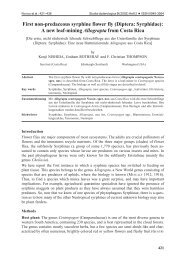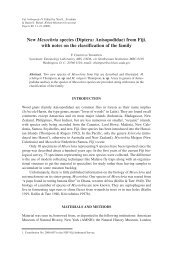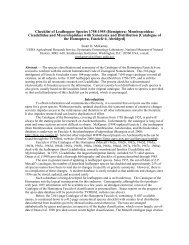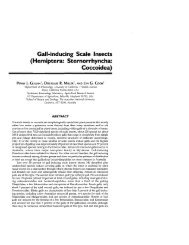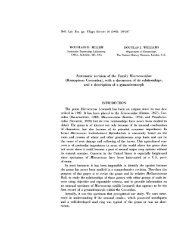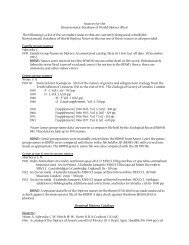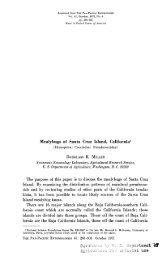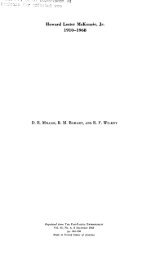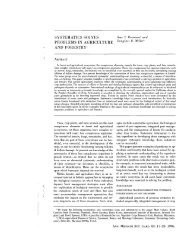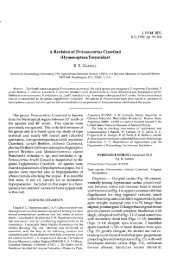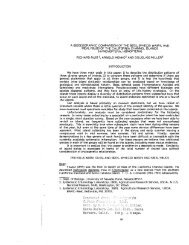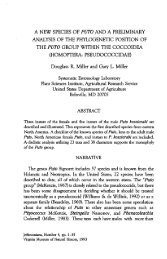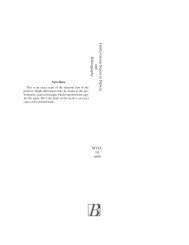- Page 1 and 2: Nota Bene: This is an exact copy of
- Page 3: Fruit Fly Expert Identification Sys
- Page 6 and 7: Fruit Fly Expert Identification Sys
- Page 8: To Richard H. Foote 1918- Who had t
- Page 11 and 12: Contributing Authors Carroll, Lynn
- Page 13 and 14: 2 MYIA Volume 9
- Page 15: 4 MYIA Volume 9
- Page 19 and 20: 8 MYIA Volume 9
- Page 21 and 22: 10 MYIA Volume 9 Subfamily Phytalmi
- Page 23 and 24: 12 MYIA Volume 9 Meracanthomyia: AF
- Page 25 and 26: 14 MYIA Volume 9 1993[2600]: 47 (ke
- Page 27 and 28: 16 MYIA Volume 9 Genera: NE, 5 (2);
- Page 29 and 30: 18 MYIA Volume 9 Peratomixis: AF, 1
- Page 31 and 32: 20 MYIA Volume 9 as a separate trib
- Page 33 and 34: 22 MYIA Volume 9 host association w
- Page 35 and 36: 24 MYIA Volume 9 Fig. 1. Valid and
- Page 37 and 38: 26 MYIA Volume 9 Table 4. Genera an
- Page 39 and 40: 28 MYIA Volume 9 Ceratitella toment
- Page 41 and 42: 30 MYIA Volume 9 Palearctic species
- Page 43 and 44: 32 MYIA Volume 9 the descriptions t
- Page 45 and 46: 34 MYIA Volume 9 Other Studies Male
- Page 47 and 48: 36 MYIA Volume 9 Headrick & Goeden
- Page 49 and 50: 38 MYIA Volume 9 ocepta, Zacerata,
- Page 51 and 52: 40 MYIA Volume 9 & Kaplan (1993) re
- Page 53 and 54: 42 MYIA Volume 9 mens from Java are
- Page 55 and 56: 44 MYIA Volume 9 NZAC New Zealand A
- Page 57 and 58: 46 MYIA Volume 9 carrejo@biologia.u
- Page 59 and 60: 48 MYIA Volume 9
- Page 61 and 62: 50 MYIA Volume 9 Format Information
- Page 63 and 64: 52 MYIA Volume 9 Family-group-name
- Page 65 and 66: 54 MYIA Volume 9 56 = Unavailable:
- Page 67 and 68:
56 MYIA Volume 9 Author, Vaild Genu
- Page 69 and 70:
58 MYIA Volume 9 Acryonyms and Name
- Page 71 and 72:
60 MYIA Volume 9 NMBZ National Muse
- Page 73 and 74:
Fig. 1. Biotic Regions of the World
- Page 75 and 76:
64 MYIA Volume 9
- Page 77 and 78:
66 MYIA Volume 9 fuscipennis. India
- Page 79 and 80:
68 MYIA Volume 9 dilutata. Japan (H
- Page 81 and 82:
70 MYIA Volume 9 aurata. Bolivia, A
- Page 83 and 84:
72 MYIA Volume 9 plumosa. China (Zh
- Page 85 and 86:
74 MYIA Volume 9 montana. India, Ch
- Page 87 and 88:
76 MYIA Volume 9 Moritsugia Shiraki
- Page 89 and 90:
78 MYIA Volume 9 Anastrepha conjunc
- Page 91 and 92:
80 MYIA Volume 9 hastata. “Amazon
- Page 93 and 94:
82 MYIA Volume 9 Anastrepha punctat
- Page 95 and 96:
84 MYIA Volume 9 venustus. Japan (H
- Page 97 and 98:
86 MYIA Volume 9 Urophora petiolata
- Page 99 and 100:
88 MYIA Volume 9 albistrigata. Indi
- Page 101 and 102:
90 MYIA Volume 9 decumana. Bougainv
- Page 103 and 104:
92 MYIA Volume 9 1995: 251. Suspens
- Page 105 and 106:
94 MYIA Volume 9 parafrauenfeldi. A
- Page 107 and 108:
96 MYIA Volume 9 trifaria. New Brit
- Page 109 and 110:
98 MYIA Volume 9 melanoscutata. New
- Page 111 and 112:
100 MYIA Volume 9 Dacus yayeyamanus
- Page 113 and 114:
102 MYIA Volume 9 anchitrichota. Pa
- Page 115 and 116:
104 MYIA Volume 9 tau. India & Sri
- Page 117 and 118:
106 MYIA Volume 9 diva. Mexico (Jal
- Page 119 and 120:
108 MYIA Volume 9 REFS—Wulp 1899[
- Page 121 and 122:
110 MYIA Volume 9 distincta. Canada
- Page 123 and 124:
112 MYIA Volume 9 lubrica. Kazaksta
- Page 125 and 126:
114 MYIA Volume 9 Paroxyna shansian
- Page 127 and 128:
116 MYIA Volume 9 Genus CARPOPHTHOR
- Page 129 and 130:
118 MYIA Volume 9 Genus CELIDOSPHEN
- Page 131 and 132:
120 MYIA Volume 9 capitata. tropica
- Page 133 and 134:
122 MYIA Volume 9 1970[4087]: 151 (
- Page 135 and 136:
124 MYIA Volume 9 ermolenkoi. Armen
- Page 137 and 138:
126 MYIA Volume 9 hammersteini. Mad
- Page 139 and 140:
128 MYIA Volume 9 Genus CRASPEDOXAN
- Page 141 and 142:
130 MYIA Volume 9 1924[470]: 452, 4
- Page 143 and 144:
132 MYIA Volume 9 bequaerti. Zaire
- Page 145 and 146:
134 MYIA Volume 9 ancisus. Angola [
- Page 147 and 148:
136 MYIA Volume 9 tubatus. Tanzania
- Page 149 and 150:
138 MYIA Volume 9 amberiens. Madaga
- Page 151 and 152:
140 MYIA Volume 9 fasciata. India,
- Page 153 and 154:
142 MYIA Volume 9 Genus DRACONTOMYI
- Page 155 and 156:
144 MYIA Volume 9 Ensinia Hardy & F
- Page 157 and 158:
146 MYIA Volume 9 REFS—Hering 194
- Page 159 and 160:
148 MYIA Volume 9 ocellata. Philipp
- Page 161 and 162:
150 MYIA Volume 9 perkinsi. Indones
- Page 163 and 164:
152 MYIA Volume 9 jamaicensis. Jama
- Page 165 and 166:
154 MYIA Volume 9 apicemaculata. Bu
- Page 167 and 168:
156 MYIA Volume 9 tricolor. USA (So
- Page 169 and 170:
158 MYIA Volume 9 ibis. Mongolia, C
- Page 171 and 172:
160 MYIA Volume 9 Genus HEXAMELA He
- Page 173 and 174:
162 MYIA Volume 9 circinata. Canada
- Page 175 and 176:
164 MYIA Volume 9 gladiatrix. Ugand
- Page 177 and 178:
166 MYIA Volume 9 gamma. Sri Lanka
- Page 179 and 180:
168 MYIA Volume 9 Genus MIGMELLA Mi
- Page 181 and 182:
170 MYIA Volume 9 Nygmatia stylata
- Page 183 and 184:
172 MYIA Volume 9 Genus NEORTALOTRY
- Page 185 and 186:
174 MYIA Volume 9 fuelleborni. Tanz
- Page 187 and 188:
176 MYIA Volume 9 latifasciata. Alg
- Page 189 and 190:
178 MYIA Volume 9 Genus OROTAVA Oro
- Page 191 and 192:
180 MYIA Volume 9 Oxyna femoralis R
- Page 193 and 194:
182 MYIA Volume 9 Genus PARACIURA P
- Page 195 and 196:
184 MYIA Volume 9 debskii. Egypt, I
- Page 197 and 198:
186 MYIA Volume 9 fukienensis. Chin
- Page 199 and 200:
188 MYIA Volume 9 Feshyia Ito 1984[
- Page 201 and 202:
190 MYIA Volume 9 Genus PHORELLIOSO
- Page 203 and 204:
192 MYIA Volume 9 discoidea. Britai
- Page 205 and 206:
194 MYIA Volume 9 Paranoplomus Shir
- Page 207 and 208:
196 MYIA Volume 9 anteapicalis. Bol
- Page 209 and 210:
198 MYIA Volume 9 aida. Ethiopia [A
- Page 211 and 212:
200 MYIA Volume 9 [NE, NT, PA]); Be
- Page 213 and 214:
202 MYIA Volume 9 ramosae. Mexico (
- Page 215 and 216:
204 MYIA Volume 9 REFS—Bezzi 1913
- Page 217 and 218:
206 MYIA Volume 9 psiloides. Indone
- Page 219 and 220:
208 MYIA Volume 9 Spathulina elegan
- Page 221 and 222:
210 MYIA Volume 9 vernoniicola. Eri
- Page 223 and 224:
212 MYIA Volume 9 Trypeta cuculi Ki
- Page 225 and 226:
214 MYIA Volume 9 sexincisa. e. Rus
- Page 227 and 228:
216 MYIA Volume 9 Tephritis conura
- Page 229 and 230:
218 MYIA Volume 9 multiguttulata. C
- Page 231 and 232:
220 MYIA Volume 9 subpura. USA (coa
- Page 233 and 234:
222 MYIA Volume 9 Musca lappae Cede
- Page 235 and 236:
224 MYIA Volume 9 bicalcaratus. Aus
- Page 237 and 238:
226 MYIA Volume 9 perkinsi. Indones
- Page 239 and 240:
228 MYIA Volume 9 pura. Cuba, Puert
- Page 241 and 242:
230 MYIA Volume 9 queritum. Kenya [
- Page 243 and 244:
232 MYIA Volume 9 candida. Argentin
- Page 245 and 246:
234 MYIA Volume 9 Trypanea microsti
- Page 247 and 248:
236 MYIA Volume 9 putata. Brazil (S
- Page 249 and 250:
238 MYIA Volume 9 suspecta. Chile (
- Page 251 and 252:
240 MYIA Volume 9 striata. Mexico (
- Page 253 and 254:
242 MYIA Volume 9 formosana. Taiwan
- Page 255 and 256:
244 MYIA Volume 9 tenuis. China [PA
- Page 257 and 258:
246 MYIA Volume 9 Acidiella mimica
- Page 259 and 260:
248 MYIA Volume 9 Aciura alata Beck
- Page 261 and 262:
250 MYIA Volume 9 claripennis. Fran
- Page 263 and 264:
252 MYIA Volume 9
- Page 265 and 266:
254 MYIA VOLUME 9 adila Richter Hen
- Page 267 and 268:
256 MYIA VOLUME 9 antica Wiedemann
- Page 269 and 270:
258 MYIA VOLUME 9 barrettoi Zucchi
- Page 271 and 272:
260 MYIA VOLUME 9 bryoniae Meigen C
- Page 273 and 274:
262 MYIA VOLUME 9 cislimitensis Ste
- Page 275 and 276:
264 MYIA VOLUME 9 curitis Stone Ana
- Page 277 and 278:
266 MYIA VOLUME 9 doronici Robineau
- Page 279 and 280:
268 MYIA VOLUME 9 fasciata Walker G
- Page 281 and 282:
270 MYIA VOLUME 9 fuscinervis Mallo
- Page 283 and 284:
272 MYIA VOLUME 9 hexachaeta: Petne
- Page 285 and 286:
274 MYIA VOLUME 9 isshikii Matsumur
- Page 287 and 288:
276 MYIA VOLUME 9 lindbergi Hering
- Page 289 and 290:
278 MYIA VOLUME 9 maripilosa Munro
- Page 291 and 292:
280 MYIA VOLUME 9 mucronota Stone A
- Page 293 and 294:
282 MYIA VOLUME 9 notandum Munro Tr
- Page 295 and 296:
284 MYIA VOLUME 9 palpata Hendel He
- Page 297 and 298:
286 MYIA VOLUME 9 picturata Hardy D
- Page 299 and 300:
288 MYIA VOLUME 9 punctilabris Bezz
- Page 301 and 302:
290 MYIA VOLUME 9 ruficauda Fabrici
- Page 303 and 304:
292 MYIA VOLUME 9 signatifacies Har
- Page 305 and 306:
294 MYIA VOLUME 9 Stylia Robineau-D
- Page 307 and 308:
296 MYIA VOLUME 9 Triandomelaena Ha
- Page 309 and 310:
298 MYIA VOLUME 9 vestigiale Hering
- Page 311 and 312:
300 MYIA VOLUME 9
- Page 313 and 314:
302 MYIA Volume 9
- Page 315 and 316:
304 MYIA Volume 9 Abrahamson, W. G.
- Page 317 and 318:
306 MYIA Volume 9 CCS36 and CCS38.
- Page 319 and 320:
308 MYIA Volume 9 Cavalloro, ed., F
- Page 321 and 322:
310 MYIA Volume 9 Anon. 1979. Anon.
- Page 323 and 324:
312 MYIA Volume 9 Averill, A. L., E
- Page 325 and 326:
314 MYIA Volume 9 Ballou, L. M. 192
- Page 327 and 328:
316 MYIA Volume 9 Bayer v Brne, E.
- Page 329 and 330:
318 MYIA Volume 9 Berlocher, S. H.,
- Page 331 and 332:
320 MYIA Volume 9 Bezzi, M. 1927. S
- Page 333 and 334:
322 MYIA Volume 9 Blangez, B. 1989.
- Page 335 and 336:
324 MYIA Volume 9 Brandhorst, C. T.
- Page 337 and 338:
326 MYIA Volume 9 salis and Dacus c
- Page 339 and 340:
328 MYIA Volume 9 with McPhail trap
- Page 341 and 342:
330 MYIA Volume 9 Carrejo, N. S. &
- Page 343 and 344:
332 MYIA Volume 9 Chiu, H. T. 1990.
- Page 345 and 346:
334 MYIA Volume 9 Cole, F. R. 1969.
- Page 347 and 348:
336 MYIA Volume 9 Coquillett, D. W.
- Page 349 and 350:
338 MYIA Volume 9 notes on others o
- Page 351 and 352:
340 MYIA Volume 9 posium, Rome, 7-1
- Page 353 and 354:
342 MYIA Volume 9 des noms scientif
- Page 355 and 356:
344 MYIA Volume 9 Dirlbek, K. 1982.
- Page 357 and 358:
346 MYIA Volume 9 Drew, R. A. I. 19
- Page 359 and 360:
348 MYIA Volume 9 Duponchel, P. 184
- Page 361 and 362:
350 MYIA Volume 9 Emmart, E. W. 193
- Page 363 and 364:
352 MYIA Volume 9 Fakalata, O. K. 1
- Page 365 and 366:
354 MYIA Volume 9 pests, Vol. 3(A).
- Page 367 and 368:
356 MYIA Volume 9 Foote, R. H. 1960
- Page 369 and 370:
358 MYIA Volume 9 Freidberg, A. 197
- Page 371 and 372:
360 MYIA Volume 9 Frick, K. E. 1972
- Page 373 and 374:
362 MYIA Volume 9 Gerstaecker, A. 1
- Page 375 and 376:
364 MYIA Volume 9 Tephritidae). Pan
- Page 377 and 378:
366 MYIA Volume 9 Gordh, G. 1979. F
- Page 379 and 380:
368 MYIA Volume 9 Guerin-Meneville,
- Page 381 and 382:
370 MYIA Volume 9 Hancock, D. L. 19
- Page 383 and 384:
372 MYIA Volume 9 Hardy, D. E. 1980
- Page 385 and 386:
374 MYIA Volume 9 near 500 figures,
- Page 387 and 388:
376 MYIA Volume 9 Headrick, D. H. &
- Page 389 and 390:
378 MYIA Volume 9 Hendel, F. G. 192
- Page 391 and 392:
380 MYIA Volume 9 Beitrag zur Kennt
- Page 393 and 394:
382 MYIA Volume 9 zur Kenntnis der
- Page 395 and 396:
384 MYIA Volume 9 Hoebeke, E. R. 19
- Page 397 and 398:
386 MYIA Volume 9 Hurtado, H. Celed
- Page 399 and 400:
388 MYIA Volume 9 Ito, S. 1948. Ube
- Page 401 and 402:
390 MYIA Volume 9 Jang, E. B., D. M
- Page 403 and 404:
392 MYIA Volume 9 Johnson, C. W. 19
- Page 405 and 406:
394 MYIA Volume 9 Kandybina, M. N.
- Page 407 and 408:
396 MYIA Volume 9 Katsoris, P. G. &
- Page 409 and 410:
398 MYIA Volume 9 Kitching, W., J.
- Page 411 and 412:
400 MYIA Volume 9 [In Russian; Engl
- Page 413 and 414:
402 MYIA Volume 9 Kuba, H. 1987. Se
- Page 415 and 416:
404 MYIA Volume 9 male-produced sex
- Page 417 and 418:
406 MYIA Volume 9 Leefmans, S. 1915
- Page 419 and 420:
408 MYIA Volume 9 Lima, A. M. da Co
- Page 421 and 422:
410 MYIA Volume 9 Liu, Y. C. & J. S
- Page 423 and 424:
412 MYIA Volume 9 Macquart, J. P. M
- Page 425 and 426:
414 MYIA Volume 9 Malloch, J. R. 19
- Page 427 and 428:
416 MYIA Volume 9 Marquardt, K. 198
- Page 429 and 430:
418 MYIA Volume 9 Mayo, I., M. Ande
- Page 431 and 432:
420 MYIA Volume 9 Morse, R.L. Metca
- Page 433 and 434:
422 MYIA Volume 9 Messina, F. J., D
- Page 435 and 436:
424 MYIA Volume 9 tario. Proc. Ento
- Page 437 and 438:
426 MYIA Volume 9 Munro, H. K. Munr
- Page 439 and 440:
428 MYIA Volume 9 Munro, H. K. 1969
- Page 441 and 442:
430 MYIA Volume 9 Neuenschwander, P
- Page 443 and 444:
432 MYIA Volume 9 Anastrepha Schine
- Page 445 and 446:
434 MYIA Volume 9 Opp, S. B., S. A.
- Page 447 and 448:
436 MYIA Volume 9 Liedo F., eds., F
- Page 449 and 450:
438 MYIA Volume 9 Phillips, V. T. 1
- Page 451 and 452:
440 MYIA Volume 9 Prescott, J. A.,
- Page 453 and 454:
442 MYIA Volume 9 Prokopy, R. J., C
- Page 455 and 456:
444 MYIA Volume 9 Raga, A., M. E. S
- Page 457 and 458:
446 MYIA Volume 9 Remund, U. & E. F
- Page 459 and 460:
448 MYIA Volume 9 Robacker, D. C.,
- Page 461 and 462:
450 MYIA Volume 9 Roitberg, B. D. &
- Page 463 and 464:
452 MYIA Volume 9 Rozhkov, A. S. 19
- Page 465 and 466:
454 MYIA Volume 9 Schaefer, M. 1992
- Page 467 and 468:
456 MYIA Volume 9 Seguy, E. 1934. D
- Page 469 and 470:
458 MYIA Volume 9 Shelly, T. E. & K
- Page 471 and 472:
460 MYIA Volume 9 Silvestri, F. 191
- Page 473 and 474:
462 MYIA Volume 9 Smyth, E. G. 1960
- Page 475 and 476:
464 MYIA Volume 9 Stanionyte, A. &
- Page 477 and 478:
466 MYIA Volume 9 Steyskal, G. C. 1
- Page 479 and 480:
468 MYIA Volume 9 [For other parts
- Page 481 and 482:
470 MYIA Volume 9 Tan, K. H. & R. N
- Page 483 and 484:
472 MYIA Volume 9 Thompson, M. T. 1
- Page 485 and 486:
474 MYIA Volume 9 Turner, C. E., G.
- Page 487 and 488:
476 MYIA Volume 9 Varley, G. C. 194
- Page 489 and 490:
478 MYIA Volume 9 Walker, F. 1858.
- Page 491 and 492:
480 MYIA Volume 9 Wasbauer, M. S. 1
- Page 493 and 494:
482 MYIA Volume 9 founded on the na
- Page 495 and 496:
484 MYIA Volume 9 Wiesmann, R. 1938
- Page 497 and 498:
486 MYIA Volume 9 Woodburn, T. L. 1
- Page 499 and 500:
488 MYIA Volume 9 Peninsular Malays
- Page 501 and 502:
490 MYIA Volume 9 Zetterstedt, J. W
- Page 503 and 504:
492 MYIA Volume 9 carried out durin
- Page 505 and 506:
494 MYIA Volume 9 An. Inst. Biol. U
- Page 507 and 508:
496 MYIA Volume 9 Bishop Mus. Occas
- Page 509 and 510:
498 MYIA Volume 9 C. R. Hebd. Seanc
- Page 511 and 512:
500 MYIA Volume 9 Entomography = En
- Page 513 and 514:
502 MYIA Volume 9 Landwirtschaft. S
- Page 515 and 516:
504 MYIA Volume 9 Kinugasa Gakuho =
- Page 517 and 518:
506 MYIA Volume 9 Naturalists’ Ha
- Page 519 and 520:
508 MYIA Volume 9 Proc. Int. Congr.
- Page 521 and 522:
510 MYIA Volume 9 Reveil Agr. = ?Re
- Page 523 and 524:
512 MYIA Volume 9 Univ. Calif. Div.
- Page 526 and 527:
Thompson Acknowledgements 515 Produ
- Page 528 and 529:
DIPTERA DATA DISSEMINATION DISK Vol
- Page 530 and 531:
Volume 1 Diptera Data Dissemination
- Page 532 and 533:
Volume 1 Diptera Data Dissemination
- Page 534 and 535:
Volume 1 Diptera Data Dissemination



